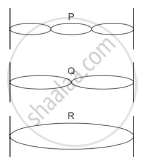Advertisements
Advertisements
प्रश्न
The adjacent diagram shows three different modes of vibrations P, Q and R of the same string.

(i) Which vibration will produce a louder sound and why?
(ii) The sound of which string will have maximum shrillness?
(iii) State the ratio of wavelengths of P and R.
उत्तर १
(i) The loudness or softness of a sound is determined by the amplitude (or intensity) of the wave. In this case the amplitude of R is greater than the amplitude of other vibration modes. Hence, the vibration R will produce more sound than the other two. Louder sound corresponds to the wave of larger amplitude.
(ii) Shrillness or Pitch of a note depends on the wavelength or frequency of wave and here the vibration P has m ore frequency than others. If f is the principle frequency, then
Frequency (P) = 3 f
Frequency (Q) = 2 f
Frequency (R) = f
Hence P has more shrillness than others.
(iii) If the frequency of vibration of R = f, frequency of vibration of Q = 2f, and that of P =3 f.
`Ratio f_P/f_R=3/1`
`f_P:f_R=3:1`
As `fprop1/lambda` hence `lambda_P/lambda_R=1:3`
OR (Another method)
From figure we can say that 3 vibration of P corresponds to 1 vibration of R

i.e `3lambda_P=1lambdaR`
`thereforelambda_P/lambda_R=1/3=1:3`
Therefore, ratio of wavelength of P and R is 1:3.
उत्तर २
(i) Vibration R as its amplitude is high as loudness ∝ A2
(ii) Sound of string ‘P’ will have maximum shrillness as its frequency is maximum.
Pitch ∝ frequency.
(iii) λP : λR = 3 : 1
संबंधित प्रश्न
What are mechanical waves?
In following figure shows two tuning forks A and B of the same frequency mounted on two separate sound boxes with their open ends facing each other. The fork A is set into vibration.
- Describe your observation.
- State the principle illustrated by this experiment.

In fig. shows two tuning forks P and Q of the same frequency mounted on separate sound boxes with their open ends facing each other. The fork A is set into vibration. (i) Describe your observation. (ii) State the principle illustrated by this experiment.

What do you mean by resonance? When does resonance occur?
Explain why stringed musical instruments, like the guitar, are provided with a hollow box.
The rearview mirror of a motorbike starts vibrating violently at some particular speed of the motorbike, what could be done to stop the violent vibrations.
Explain why does the rear mirror of a motorbike start Vibrating Violently, at some particular speed of motorbike?
A vibrating tuning fork is placed over the mouth of a burette filled with water. The tap is opened and the water level gradually falls. It is observed that the sound becomes the loudest for a particular length of the air column. What is the name of the phenomenon taking place when this happens? Why does the sound become the loudest?
